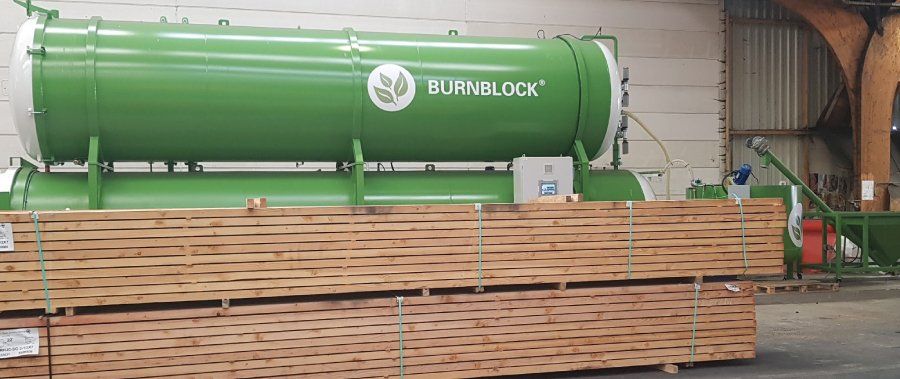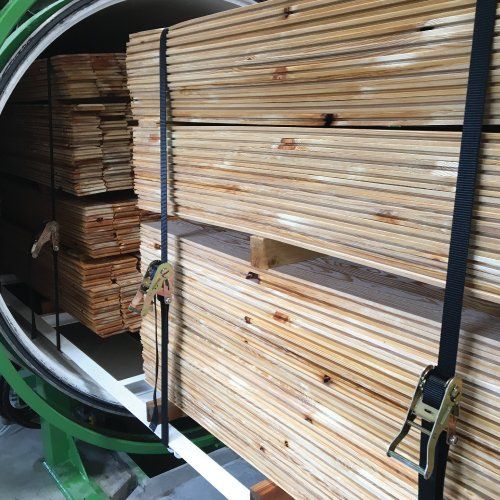Tel: 01992 414000 Email Us
Fire Rated
Fire Retardant Timber
Fire Rated Timber to Euroclass B & Euroclass C
Fire Rated Timber to Euroclass B & Euroclass C

What is Burnblock Treated Timber ?
Pressure impregnated with a fire-retardant solution to meet the requirements of Euro Class B or Euro Class C for fire-retardant classification projects. Burnblock fire-retardant is designed to reduce surface spread of flame, smoke and heat generation, whilst maintaining the natural durability and strength of the wood.
Burnblock is a non-toxic water based treatment containing only food grade ingredients, ensuring no hazardous chemical risks to treaters and users of the product. Oxygen supply is effectively blocked in the fire-threatened material. In this way Burnblock halts the burning process, just as it can counteract the ignition of treated plywood and timber.
Burnblock treatment is completed under ISO9001 controlled factory conditions and is approved to the highest classification according to the Euroclass system for building products, making it the perfect solution for most building projects. Full test data availble on request.
Why Choose Burnblock?
Borate Free
Borate Free
- Traditionally, borates are used in fire rated timber and plywood
- Sodium perborate is on the REACH candidate list of substances for very high concern
- Sodium perborate meets the criteria to be classified as toxic for reproduction. Read the ECHA support documenthere
- Burnblock is borate free
- No ingredient of Burnblock is on the REACH list or REACH candidate list
- 100% Organic. In its liquid form, bio-degrades in 14 days
- Non-harmful and non-hazardous. 100% food grade ingredients
- Waste Management - safe disposal, treat as normal timber
- Handling - no additional masks or gloves
- No additional cost implications for storage, handling & disposal
Service Life of Burnblock Treated Wood
Burnblock treatment is designed to last the life of the wood and has undergone testing to ensure durability in application. Therefore, Burnblock treated wood requires no additional maintenance to maintain the given Euro Class.
Burnblock treatment is designed to last the life of the wood and has undergone testing to ensure durability in application. Therefore, Burnblock treated wood requires no additional maintenance to maintain the given Euro Class.
Documentation
Burnblock fire-retardant is fully supported by independent tests, including species specific laboratory classification reports, which fully document the effects of treatment on natural wood products.
All technical documentation is available upon request from one of our technical team.
Burnblock fire-retardant is fully supported by independent tests, including species specific laboratory classification reports, which fully document the effects of treatment on natural wood products.
All technical documentation is available upon request from one of our technical team.
What is the appearance of treated timber?
Natural wood products can exhibit minor changes to appearance once treatment has been completed.
Vacuum impregnation process involves incorporating fire-retardant chemical into the natural wood, followed by kiln drying. Existing minor imperfections within the wood, can become more noticeable.
Dependent upon the wood species, colour variations are possible too, with slight darkening and highlighting of grain. This will fade to match non-treated timber over time, with weathering. Chemical residue may remain on the wood following treatment. Due to the non-toxic composition of Burnblock, this can be wiped off, leaving no long-lasting effect to the final product appearance.
Please discuss your project with us, we can ensure you are fully aware of potential changes to Burnblock treated wood.
Natural wood products can exhibit minor changes to appearance once treatment has been completed.
Vacuum impregnation process involves incorporating fire-retardant chemical into the natural wood, followed by kiln drying. Existing minor imperfections within the wood, can become more noticeable.
Dependent upon the wood species, colour variations are possible too, with slight darkening and highlighting of grain. This will fade to match non-treated timber over time, with weathering. Chemical residue may remain on the wood following treatment. Due to the non-toxic composition of Burnblock, this can be wiped off, leaving no long-lasting effect to the final product appearance.
Please discuss your project with us, we can ensure you are fully aware of potential changes to Burnblock treated wood.
Burnblock Applications
We advise speaking to one of our technical team to discuss product application.
Additional Services
- We offer a range of services to compliment your fire retardant timber project:
- Bespoke profile cutting
- Cut to length sections
- CNC work
- Factory applied coatings
Further Information
What is Fire Retardant (FR) Plywood and Timber?
FR timber and plywood is material that has been treated to slow the spread of fire propagation and prevent ignition. The spread of flame is measured against a known standard of EN 13501-1.
Why is FR material specified?
Increases the available time to safely evacuate a burning building
Reduces the rate of fire spread
Reduces smoke
By using FR Timber or FR Plywood you are using material that has passed and been approved to a measured standard as outlined in the Building Regulations. Treated material behaves and reacts to fire in a known and quantifiable way.
Class B or Class 0?
Class 1 and 0 were British standards BS476-7 which had started to be phased out in 2008 and completed by 2013. The standards were replaced by a harmonised European Standard. Document B refers to this harmonisation.
Document B
Building Regulations and Fire Safety Standard (2010 and 2013 amendments) - Fire Safety: Approved Document B
Volume 1 - Dwelling Houses. Volume 2 - Buildings other than Dwelling Houses.
This is a government document that specifies building regulations concerning fire. Public and private buildings 3m or 4m high.
This document outlines how to build a structure to achieve building “sign-off” from the building inspector. A Fire Officer is also involved.
The Architect and Structural Engineer will refer to Document B:
External Link to Document B
Resistance / Reaction to Fire
Resistance is measured in time (e.g. a 30 minute fire door) and usually relates to a composite, an assembled product or a constructed setup.
Reaction usually relates to individual material components, such as timber and plywood, where they are sold with a known and measured reaction to fire.
These are two different tests.
What is Fire Retardant (FR) Plywood and Timber?
FR timber and plywood is material that has been treated to slow the spread of fire propagation and prevent ignition. The spread of flame is measured against a known standard of EN 13501-1.
Why is FR material specified?
Increases the available time to safely evacuate a burning building
Reduces the rate of fire spread
Reduces smoke
By using FR Timber or FR Plywood you are using material that has passed and been approved to a measured standard as outlined in the Building Regulations. Treated material behaves and reacts to fire in a known and quantifiable way.
Class B or Class 0?
Class 1 and 0 were British standards BS476-7 which had started to be phased out in 2008 and completed by 2013. The standards were replaced by a harmonised European Standard. Document B refers to this harmonisation.
Document B
Building Regulations and Fire Safety Standard (2010 and 2013 amendments) - Fire Safety: Approved Document B
Volume 1 - Dwelling Houses. Volume 2 - Buildings other than Dwelling Houses.
This is a government document that specifies building regulations concerning fire. Public and private buildings 3m or 4m high.
This document outlines how to build a structure to achieve building “sign-off” from the building inspector. A Fire Officer is also involved.
The Architect and Structural Engineer will refer to Document B:
External Link to Document B
Resistance / Reaction to Fire
Resistance is measured in time (e.g. a 30 minute fire door) and usually relates to a composite, an assembled product or a constructed setup.
Reaction usually relates to individual material components, such as timber and plywood, where they are sold with a known and measured reaction to fire.
These are two different tests.
Contact us for a quote
As importers, we are set up to deal in commercial volumes to companies
As importers, we are set up to deal in commercial volumes to companies
Here to help - call us on 01992 414000
©
Specialised
Panel Products Ltd. Registered in England & Wales under 3500652 -
Privacy Policy



